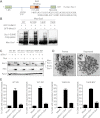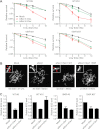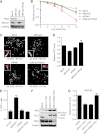Scc1 sumoylation by Mms21 promotes sister chromatid recombination through counteracting Wapl
- PMID: 22751501
- PMCID: PMC3403015
- DOI: 10.1101/gad.193615.112
Scc1 sumoylation by Mms21 promotes sister chromatid recombination through counteracting Wapl
Abstract
DNA double-strand breaks (DSBs) fuel cancer-driving chromosome translocations. Two related structural maintenance of chromosomes (Smc) complexes, cohesin and Smc5/6, promote DSB repair through sister chromatid homologous recombination (SCR). Here we show that the Smc5/6 subunit Mms21 sumoylates multiple lysines of the cohesin subunit Scc1. Mms21 promotes cohesin-dependent small ubiquitin-like modifier (SUMO) accumulation at laser-induced DNA damage sites in S/G2 human cells. Cells expressing the nonsumoylatable Scc1 mutant (15KR) maintain sister chromatid cohesion during mitosis but are defective in SCR and sensitive to ionizing radiation (IR). Scc1 15KR is recruited to DNA damage sites. Depletion of Wapl, a negative cohesin regulator, rescues SCR defects of Mms21-deficient or Scc1 15KR-expressing cells. Expression of the acetylation-mimicking Smc3 mutant does not bypass the requirement for Mms21 in SCR. We propose that Scc1 sumoylation by Mms21 promotes SCR by antagonizing Wapl at a step after cohesin loading at DSBs and in a way not solely dependent on Smc3 acetylation.
Figures







Similar articles
-
Structure of cohesin subcomplex pinpoints direct shugoshin-Wapl antagonism in centromeric cohesion.Nat Struct Mol Biol. 2014 Oct;21(10):864-70. doi: 10.1038/nsmb.2880. Epub 2014 Aug 31. Nat Struct Mol Biol. 2014. PMID: 25173175 Free PMC article.
-
Molecular mechanism and functional significance of Wapl interaction with the Cohesin complex.Proc Natl Acad Sci U S A. 2024 Aug 13;121(33):e2405177121. doi: 10.1073/pnas.2405177121. Epub 2024 Aug 7. Proc Natl Acad Sci U S A. 2024. PMID: 39110738 Free PMC article.
-
Releasing the cohesin ring: A rigid scaffold model for opening the DNA exit gate by Pds5 and Wapl.Bioessays. 2017 Apr;39(4). doi: 10.1002/bies.201600207. Epub 2017 Feb 21. Bioessays. 2017. PMID: 28220956 Review.
-
Studying meiotic cohesin in somatic cells reveals that Rec8-containing cohesin requires Stag3 to function and is regulated by Wapl and sororin.J Cell Sci. 2018 Jun 11;131(11):jcs212100. doi: 10.1242/jcs.212100. J Cell Sci. 2018. PMID: 29724914
-
The Nse2/Mms21 SUMO ligase of the Smc5/6 complex in the maintenance of genome stability.FEBS Lett. 2011 Sep 16;585(18):2907-13. doi: 10.1016/j.febslet.2011.04.067. Epub 2011 May 4. FEBS Lett. 2011. PMID: 21550342 Review.
Cited by
-
Dynamic localization of SMC5/6 complex proteins during mammalian meiosis and mitosis suggests functions in distinct chromosome processes.J Cell Sci. 2013 Sep 15;126(Pt 18):4239-52. doi: 10.1242/jcs.130195. Epub 2013 Jul 10. J Cell Sci. 2013. PMID: 23843628 Free PMC article.
-
RAD21 is a driver of chromosome 8 gain in Ewing sarcoma to mitigate replication stress.Genes Dev. 2021 Apr 1;35(7-8):556-572. doi: 10.1101/gad.345454.120. Epub 2021 Mar 25. Genes Dev. 2021. PMID: 33766983 Free PMC article.
-
The Emerging Role of Cohesin in the DNA Damage Response.Genes (Basel). 2018 Nov 28;9(12):581. doi: 10.3390/genes9120581. Genes (Basel). 2018. PMID: 30487431 Free PMC article. Review.
-
MCM2-7-dependent cohesin loading during S phase promotes sister-chromatid cohesion.Elife. 2018 Apr 3;7:e33920. doi: 10.7554/eLife.33920. Elife. 2018. PMID: 29611806 Free PMC article.
-
Independent mechanisms recruit the cohesin loader protein NIPBL to sites of DNA damage.J Cell Sci. 2017 Mar 15;130(6):1134-1146. doi: 10.1242/jcs.197236. Epub 2017 Feb 6. J Cell Sci. 2017. PMID: 28167679 Free PMC article.
References
-
- Behlke-Steinert S, Touat-Todeschini L, Skoufias DA, Margolis RL 2009. SMC5 and MMS21 are required for chromosome cohesion and mitotic progression. Cell Cycle 8: 2211–2218 - PubMed
-
- Berkovich E, Monnat RJ Jr, Kastan MB 2007. Roles of ATM and NBS1 in chromatin structure modulation and DNA double-strand break repair. Nat Cell Biol 9: 683–690 - PubMed
-
- Berkovich E, Monnat RJ Jr, Kastan MB 2008. Assessment of protein dynamics and DNA repair following generation of DNA double-strand breaks at defined genomic sites. Nat Protoc 3: 915–922 - PubMed
-
- De Piccoli G, Torres-Rosell J, Aragon L 2009. The unnamed complex: What do we know about Smc5–Smc6? Chromosome Res 17: 251–263 - PubMed
Publication types
MeSH terms
Substances
Grants and funding
LinkOut - more resources
Full Text Sources
Molecular Biology Databases
Research Materials
Miscellaneous
